Medscape CME Activity
Medscape, LLC is pleased to provide online continuing medical education (CME) for selected journal articles, allowing clinicians the opportunity to earn CME credit. In support of improving patient care, these activities have been planned and implemented by Medscape, LLC and Emerging Infectious Diseases. Medscape, LLC is jointly accredited by the Accreditation Council for Continuing Medical Education (ACCME), the Accreditation Council for Pharmacy Education (ACPE), and the American Nurses Credentialing Center (ANCC), to provide continuing education for the healthcare team.
CME credit is available for one year after publication.
Volume 25—2019
Volume 25, Number 12—December 2019
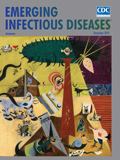
In 2014, vaccinia virus (VACV) infections were identified among farmworkers in Caquetá Department, Colombia; additional cases were identified in Cundinamarca Department in 2015. VACV, an orthopoxvirus (OPXV) used in the smallpox vaccine, has caused sporadic bovine and human outbreaks in countries such as Brazil and India. In response to the emergence of this disease in Colombia, we surveyed and collected blood from 134 farmworkers and household members from 56 farms in Cundinamarca Department. We tested serum samples for OPXV antibodies and correlated risk factors with seropositivity by using multivariate analyses. Fifty-two percent of farmworkers had OPXV antibodies; this percentage decreased to 31% when we excluded persons who would have been eligible for smallpox vaccination. The major risk factors for seropositivity were municipality, age, smallpox vaccination scar, duration of time working on a farm, and animals having vaccinia-like lesions. This investigation provides evidence for possible emergence of VACV as a zoonosis in South America.
| EID | Styczynski A, Burgado J, Walteros D, Usme-Ciro J, Laiton K, Farias A, et al. Seroprevalence and Risk Factors Possibly Associated with Emerging Zoonotic Vaccinia Virus in a Farming Community, Colombia. Emerg Infect Dis. 2019;25(12):2169-2176. https://doi.org/10.3201/eid2512.181114 |
|---|---|
| AMA | Styczynski A, Burgado J, Walteros D, et al. Seroprevalence and Risk Factors Possibly Associated with Emerging Zoonotic Vaccinia Virus in a Farming Community, Colombia. Emerging Infectious Diseases. 2019;25(12):2169-2176. doi:10.3201/eid2512.181114. |
| APA | Styczynski, A., Burgado, J., Walteros, D., Usme-Ciro, J., Laiton, K., Farias, A....Petersen, B. (2019). Seroprevalence and Risk Factors Possibly Associated with Emerging Zoonotic Vaccinia Virus in a Farming Community, Colombia. Emerging Infectious Diseases, 25(12), 2169-2176. https://doi.org/10.3201/eid2512.181114. |
Streptococcus suis is an emerging agent of zoonotic bacterial meningitis in Asia. We describe the epidemiology of S. suis cases and clinical signs and microbiological findings in persons with meningitis in Bali, Indonesia, using patient data and bacterial cultures of cerebrospinal fluid collected during 2014–2017. We conducted microbiological assays using the fully automatic VITEK 2 COMPACT system. We amplified and sequenced gene fragments of glutamate dehydrogenase and recombination/repair protein and conducted PCR serotyping to confirm some serotypes. Of 71 cases, 44 were confirmed as S. suis; 29 isolates were serotype 2. The average patient age was 48.1 years, and 89% of patients were male. Seventy-seven percent of patients with confirmed cases recovered without complications; 11% recovered with septic shock, 7% with deafness, and 2% with deafness and arthritis. The case-fatality rate was 11%. Awareness of S. suis infection risk must be increased in health promotion activities in Bali.
| EID | Susilawathi N, Tarini N, Fatmawati N, Mayura P, Suryapraba A, Subrata M, et al. Streptococcus suis–Associated Meningitis, Bali, Indonesia, 2014–2017. Emerg Infect Dis. 2019;25(12):2235-2242. https://doi.org/10.3201/eid2512.181709 |
|---|---|
| AMA | Susilawathi N, Tarini N, Fatmawati N, et al. Streptococcus suis–Associated Meningitis, Bali, Indonesia, 2014–2017. Emerging Infectious Diseases. 2019;25(12):2235-2242. doi:10.3201/eid2512.181709. |
| APA | Susilawathi, N., Tarini, N., Fatmawati, N., Mayura, P., Suryapraba, A., Subrata, M....Mahardika, G. (2019). Streptococcus suis–Associated Meningitis, Bali, Indonesia, 2014–2017. Emerging Infectious Diseases, 25(12), 2235-2242. https://doi.org/10.3201/eid2512.181709. |
Volume 25, Number 11—November 2019
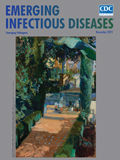
West Nile Virus (WNV) can result in clinically severe neurologic disease. There is no treatment for WNV infection, but administration of anti-WNV polyclonal human antibody has demonstrated efficacy in animal models. We compared Omr-IgG-am, an immunoglobulin product with high titers of anti-WNV antibody, with intravenous immunoglobulin (IVIG) and normal saline to assess safety and efficacy in patients with WNV neuroinvasive disease as part of a phase I/II, randomized, double-blind, multicenter study in North America. During 2003–2006, a total of 62 hospitalized patients were randomized to receive Omr-IgG-am, standard IVIG, or normal saline (3:1:1). The primary endpoint was medication safety. Secondary endpoints were morbidity and mortality, measured using 4 standardized assessments of cognitive and functional status. The death rate in the study population was 12.9%. No significant differences were found between groups receiving Omr-IgG-am compared with IVIG or saline for either the safety or efficacy endpoints.
| EID | Gnann JW, Agrawal A, Hart J, Buitrago M, Carson P, Hanfelt-Goade D, et al. Lack of Efficacy of High-Titered Immunoglobulin in Patients with West Nile Virus Central Nervous System Disease. Emerg Infect Dis. 2019;25(11):2064-2073. https://doi.org/10.3201/eid2511.190537 |
|---|---|
| AMA | Gnann JW, Agrawal A, Hart J, et al. Lack of Efficacy of High-Titered Immunoglobulin in Patients with West Nile Virus Central Nervous System Disease. Emerging Infectious Diseases. 2019;25(11):2064-2073. doi:10.3201/eid2511.190537. |
| APA | Gnann, J. W., Agrawal, A., Hart, J., Buitrago, M., Carson, P., Hanfelt-Goade, D....Whitley, R. J. (2019). Lack of Efficacy of High-Titered Immunoglobulin in Patients with West Nile Virus Central Nervous System Disease. Emerging Infectious Diseases, 25(11), 2064-2073. https://doi.org/10.3201/eid2511.190537. |
Volume 25, Number 10—October 2019

Edwardsiella tarda is primarily associated with gastrointestinal disease, but an increasing number of cases involving extraintestinal disease, especially E. tarda bacteremia, have been reported. Using clinical information of E. tarda bacteremia patients identified during January 2005–December 2016 in Japan, we characterized the clinical epidemiology of E. tarda bacteremia. A total of 182,668 sets of blood cultures were obtained during the study period; 40 (0.02%) sets from 26 patients were positive for E. tarda. The most common clinical manifestations were hepatobiliary infection, including cholangitis, liver abscess, and cholecystitis. Overall 30-day mortality for E. tarda bacteremia was 12%, and overall 90-day mortality was 27%. The incidence of E. tarda infection did not vary by season. We more frequently observed hepatobiliary infection in patients with E. tarda bacteremia than in patients with nonbacteremic E. tarda infections. E. tarda bacteremia is a rare entity that is not associated with high rates of death.
| EID | Kamiyama S, Kuriyama A, Hashimoto T. Edwardsiella tarda Bacteremia, Okayama, Japan, 2005–2016. Emerg Infect Dis. 2019;25(10):1817-1823. https://doi.org/10.3201/eid2510.180518 |
|---|---|
| AMA | Kamiyama S, Kuriyama A, Hashimoto T. Edwardsiella tarda Bacteremia, Okayama, Japan, 2005–2016. Emerging Infectious Diseases. 2019;25(10):1817-1823. doi:10.3201/eid2510.180518. |
| APA | Kamiyama, S., Kuriyama, A., & Hashimoto, T. (2019). Edwardsiella tarda Bacteremia, Okayama, Japan, 2005–2016. Emerging Infectious Diseases, 25(10), 1817-1823. https://doi.org/10.3201/eid2510.180518. |
We conducted a retrospective study on all cases of pneumococcal septic arthritis (SA) in patients >18 years of age reported to the Picardie Regional Pneumococcal Network in France during 2005–2016. Among 1,062 cases of invasive pneumococcal disease, we observed 16 (1.5%) SA cases. Although SA is uncommon in adult patients, the prevalence of pneumococcal SA in the Picardie region increased from 0.69% during 2005–2010 to 2.47% during 2011–2016 after introduction of the pneumococcal 13-valent conjugate vaccine. We highlight the emergence of SA cases caused by the 23B serotype, which is not covered in the vaccine.
| EID | Dernoncourt A, El Samad Y, Schmidt J, Emond J, Gouraud C, Brocard A, et al. Case Studies and Literature Review of Pneumococcal Septic Arthritis in Adults. Emerg Infect Dis. 2019;25(10):1824-1833. https://doi.org/10.3201/eid2510.181695 |
|---|---|
| AMA | Dernoncourt A, El Samad Y, Schmidt J, et al. Case Studies and Literature Review of Pneumococcal Septic Arthritis in Adults. Emerging Infectious Diseases. 2019;25(10):1824-1833. doi:10.3201/eid2510.181695. |
| APA | Dernoncourt, A., El Samad, Y., Schmidt, J., Emond, J., Gouraud, C., Brocard, A....Hamdad, F. (2019). Case Studies and Literature Review of Pneumococcal Septic Arthritis in Adults. Emerging Infectious Diseases, 25(10), 1824-1833. https://doi.org/10.3201/eid2510.181695. |
The risk for invasive streptococcal infection has not been clearly quantified among persons experiencing homelessness (PEH). We compared the incidence of detected cases of invasive group A Streptococcus infection, group B Streptococcus infection, and Streptococcus pneumoniae (pneumococcal) infection among PEH with that among the general population in Anchorage, Alaska, USA, during 2002–2015. We used data from the Centers for Disease Control and Prevention’s Arctic Investigations Program surveillance system, the US Census, and the Anchorage Point-in-Time count (a yearly census of PEH). We detected a disproportionately high incidence of invasive streptococcal disease in Anchorage among PEH. Compared with the general population, PEH were 53.3 times as likely to have invasive group A Streptococcus infection, 6.9 times as likely to have invasive group B Streptococcus infection, and 36.3 times as likely to have invasive pneumococcal infection. Infection control in shelters, pneumococcal vaccination, and infection monitoring could help protect the health of this vulnerable group.
| EID | Mosites E, Zulz T, Bruden D, Nolen L, Frick A, Castrodale L, et al. Risk for Invasive Streptococcal Infections among Adults Experiencing Homelessness, Anchorage, Alaska, USA, 2002–2015. Emerg Infect Dis. 2019;25(10):1903-1910. https://doi.org/10.3201/eid2510.181408 |
|---|---|
| AMA | Mosites E, Zulz T, Bruden D, et al. Risk for Invasive Streptococcal Infections among Adults Experiencing Homelessness, Anchorage, Alaska, USA, 2002–2015. Emerging Infectious Diseases. 2019;25(10):1903-1910. doi:10.3201/eid2510.181408. |
| APA | Mosites, E., Zulz, T., Bruden, D., Nolen, L., Frick, A., Castrodale, L....Bruce, M. G. (2019). Risk for Invasive Streptococcal Infections among Adults Experiencing Homelessness, Anchorage, Alaska, USA, 2002–2015. Emerging Infectious Diseases, 25(10), 1903-1910. https://doi.org/10.3201/eid2510.181408. |
Volume 25, Number 9—September 2019

To evaluate a classification system to support clinical decisions for treatment of contaminated deep wounds at risk for an invasive fungal infection (IFI), we studied 246 US service members (413 wounds) injured in Afghanistan (2009–2014) who had laboratory evidence of fungal infection. A total of 143 wounds with persistent necrosis and laboratory evidence were classified as IFI; 120 wounds not meeting IFI criteria were classified as high suspicion (patients had localized infection signs/symptoms and had received antifungal medication for >10 days), and 150 were classified as low suspicion (failed to meet these criteria). IFI patients received more blood than other patients and had more severe injuries than patients in the low-suspicion group. Fungi of the order Mucorales were more frequently isolated from IFI (39%) and high-suspicion (21%) wounds than from low-suspicion (9%) wounds. Wounds that did not require immediate antifungal therapy lacked necrosis and localized signs/symptoms of infection and contained fungi from orders other than Mucorales.
| EID | Ganesan A, Shaikh F, Bradley W, Blyth DM, Bennett D, Petfield JL, et al. Classification of Trauma-Associated Invasive Fungal Infections to Support Wound Treatment Decisions. Emerg Infect Dis. 2019;25(9):1639-1647. https://doi.org/10.3201/eid2509.190168 |
|---|---|
| AMA | Ganesan A, Shaikh F, Bradley W, et al. Classification of Trauma-Associated Invasive Fungal Infections to Support Wound Treatment Decisions. Emerging Infectious Diseases. 2019;25(9):1639-1647. doi:10.3201/eid2509.190168. |
| APA | Ganesan, A., Shaikh, F., Bradley, W., Blyth, D. M., Bennett, D., Petfield, J. L....Tribble, D. R. (2019). Classification of Trauma-Associated Invasive Fungal Infections to Support Wound Treatment Decisions. Emerging Infectious Diseases, 25(9), 1639-1647. https://doi.org/10.3201/eid2509.190168. |
To assess whether risk for Clostridioides difficile infection (CDI) is higher among older adults with cancer, we conducted a retrospective cohort study with a nested case–control analysis using population-based Surveillance, Epidemiology, and End Results–Medicare linked data for 2011. Among 93,566 Medicare beneficiaries, incident CDI and odds for acquiring CDI were higher among patients with than without cancer. Specifically, risk was significantly higher for those who had liquid tumors and higher for those who had recently diagnosed solid tumors and distant metastasis. These findings were independent of prior healthcare-associated exposure. This population-based assessment can be used to identify targets for prevention of CDI.
| EID | Kamboj M, Gennarelli RL, Brite J, Sepkowitz K, Lipitz-Snyderman A. Risk for Clostridioides difficile Infection among Older Adults with Cancer. Emerg Infect Dis. 2019;25(9):1683-1689. https://doi.org/10.3201/eid2509.181142 |
|---|---|
| AMA | Kamboj M, Gennarelli RL, Brite J, et al. Risk for Clostridioides difficile Infection among Older Adults with Cancer. Emerging Infectious Diseases. 2019;25(9):1683-1689. doi:10.3201/eid2509.181142. |
| APA | Kamboj, M., Gennarelli, R. L., Brite, J., Sepkowitz, K., & Lipitz-Snyderman, A. (2019). Risk for Clostridioides difficile Infection among Older Adults with Cancer. Emerging Infectious Diseases, 25(9), 1683-1689. https://doi.org/10.3201/eid2509.181142. |
Volume 25, Number 8—August 2019

We report demographic, epidemiologic, and clinical findings for a prospective cohort of pregnant women during the initial phase of Zika virus introduction into Yucatan, Mexico. We monitored 115 pregnant women for signs of active or recent Zika virus infection. The estimated cumulative incidence of Zika virus infection was 0.31 and the ratio of symptomatic to asymptomatic cases was 1.7 (range 1.3–4.0 depending on age group). Exanthema was the most sensitive clinical sign but also the least specific. Conjunctival hyperemia, joint edema, and exanthema were the combination of signs that had the highest specificity but low sensitivity. We did not find evidence of vertical transmission or fetal anomalies, likely because of the low number of pregnant women tested. We also did not find evidence of congenital disease. Our findings emphasize the limited predictive value of clinical features in areas where Zika virus cocirculates with other flaviviruses.
| EID | Romer Y, Valadez-Gonzalez N, Contreras-Capetillo S, Manrique-Saide P, Vazquez-Prokopec G, Pavia-Ruz N. Zika Virus Infection in Pregnant Women, Yucatan, Mexico. Emerg Infect Dis. 2019;25(8):1452-1460. https://doi.org/10.3201/eid2508.180915 |
|---|---|
| AMA | Romer Y, Valadez-Gonzalez N, Contreras-Capetillo S, et al. Zika Virus Infection in Pregnant Women, Yucatan, Mexico. Emerging Infectious Diseases. 2019;25(8):1452-1460. doi:10.3201/eid2508.180915. |
| APA | Romer, Y., Valadez-Gonzalez, N., Contreras-Capetillo, S., Manrique-Saide, P., Vazquez-Prokopec, G., & Pavia-Ruz, N. (2019). Zika Virus Infection in Pregnant Women, Yucatan, Mexico. Emerging Infectious Diseases, 25(8), 1452-1460. https://doi.org/10.3201/eid2508.180915. |
Lassa fever in pregnancy causes high rates of maternal and fetal death, but limited data are available to guide clinicians. We retrospectively studied 30 pregnant Lassa fever patients treated with early ribavirin therapy and a conservative obstetric approach at a teaching hospital in southern Nigeria during January 2009–March 2018. Eleven (36.7%) of 30 women died, and 20/31 (64.5%) pregnancies ended in fetal or perinatal loss. On initial evaluation, 17/30 (56.6%) women had a dead fetus; 10/17 (58.8%) of these patients died, compared with 1/13 (7.7%) of women with a live fetus. Extravaginal bleeding, convulsions, and oliguria each were independently associated with maternal and fetal or perinatal death, whereas seeking care in the third trimester was not. For women with a live fetus at initial evaluation, the positive outcomes observed contrast with previous reports, and they support a conservative approach to obstetric management of Lassa fever in pregnancy in Nigeria.
| EID | Okogbenin S, Okoeguale J, Akpede G, Colubri A, Barnes KG, Mehta S, et al. Retrospective Cohort Study of Lassa Fever in Pregnancy, Southern Nigeria. Emerg Infect Dis. 2019;25(8):1494-1500. https://doi.org/10.3201/eid2508.181299 |
|---|---|
| AMA | Okogbenin S, Okoeguale J, Akpede G, et al. Retrospective Cohort Study of Lassa Fever in Pregnancy, Southern Nigeria. Emerging Infectious Diseases. 2019;25(8):1494-1500. doi:10.3201/eid2508.181299. |
| APA | Okogbenin, S., Okoeguale, J., Akpede, G., Colubri, A., Barnes, K. G., Mehta, S....Ogbaini-Emovon, E. (2019). Retrospective Cohort Study of Lassa Fever in Pregnancy, Southern Nigeria. Emerging Infectious Diseases, 25(8), 1494-1500. https://doi.org/10.3201/eid2508.181299. |
Volume 25, Number 7—July 2019
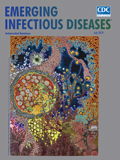
Surveys suggest that clinicians diverge from guidelines when treating Mycobacterium avium complex (MAC) pulmonary disease (PD). To determine prescribing patterns, we conducted a cohort study of adults >66 years of age in Ontario, Canada, with MAC or Mycobacterium xenopi PD during 2001–2013. Using linked laboratory and health administrative databases, we studied the first treatment episode (>60 continuous days of >1 of a macrolide, ethambutol, rifamycin, fluoroquinolone, linezolid, inhaled amikacin, or, for M. xenopi, isoniazid). Treatment was prescribed for 24% MAC and 15% of M. xenopi PD patients. Most commonly prescribed was the recommended combination of macrolide, ethambutol, and rifamycin, for 47% of MAC and 36% of M. xenopi PD patients. Among MAC PD patients, 20% received macrolide monotherapy and 33% received regimens associated with emergent macrolide resistance. Although the most commonly prescribed regimen was guidelines-recommended, many regimens prescribed for MAC PD were associated with emergent macrolide resistance.
| EID | Brode SK, Chung H, Campitelli MA, Kwong JC, Marchand-Austin A, Winthrop KL, et al. Prescribing Patterns for Treatment of Mycobacterium avium Complex and M. xenopi Pulmonary Disease in Ontario, Canada, 2001–2013. Emerg Infect Dis. 2019;25(7):1271-1280. https://doi.org/10.3201/eid2507.181817 |
|---|---|
| AMA | Brode SK, Chung H, Campitelli MA, et al. Prescribing Patterns for Treatment of Mycobacterium avium Complex and M. xenopi Pulmonary Disease in Ontario, Canada, 2001–2013. Emerging Infectious Diseases. 2019;25(7):1271-1280. doi:10.3201/eid2507.181817. |
| APA | Brode, S. K., Chung, H., Campitelli, M. A., Kwong, J. C., Marchand-Austin, A., Winthrop, K. L....Marras, T. K. (2019). Prescribing Patterns for Treatment of Mycobacterium avium Complex and M. xenopi Pulmonary Disease in Ontario, Canada, 2001–2013. Emerging Infectious Diseases, 25(7), 1271-1280. https://doi.org/10.3201/eid2507.181817. |
Candida auris is an emerging multidrug-resistant fungus that causes hospital-associated outbreaks of invasive infections with high death rates. During 2015–2016, health authorities in Colombia detected an outbreak of C. auris. We conducted an investigation to characterize the epidemiology, transmission mechanisms, and reservoirs of this organism. We investigated 4 hospitals with confirmed cases of C. auris candidemia in 3 cities in Colombia. We abstracted medical records and collected swabs from contemporaneously hospitalized patients to assess for skin colonization. We identified 40 cases; median patient age was 23 years (IQR 4 months–56 years). Twelve (30%) patients were <1 year of age, and 24 (60%) were male. The 30-day mortality was 43%. Cases clustered in time and location; axilla and groin were the most commonly colonized sites. Temporal and spatial clustering of cases and skin colonization suggest person-to-person transmission of C. auris. These cases highlight the importance of adherence to infection control recommendations.
| EID | Armstrong PA, Rivera SM, Escandon P, Caceres DH, Chow N, Stuckey MJ, et al. Hospital-Associated Multicenter Outbreak of Emerging Fungus Candida auris, Colombia, 2016. Emerg Infect Dis. 2019;25(7):1339-1346. https://doi.org/10.3201/eid2507.180491 |
|---|---|
| AMA | Armstrong PA, Rivera SM, Escandon P, et al. Hospital-Associated Multicenter Outbreak of Emerging Fungus Candida auris, Colombia, 2016. Emerging Infectious Diseases. 2019;25(7):1339-1346. doi:10.3201/eid2507.180491. |
| APA | Armstrong, P. A., Rivera, S. M., Escandon, P., Caceres, D. H., Chow, N., Stuckey, M. J....Pacheco, O. (2019). Hospital-Associated Multicenter Outbreak of Emerging Fungus Candida auris, Colombia, 2016. Emerging Infectious Diseases, 25(7), 1339-1346. https://doi.org/10.3201/eid2507.180491. |
Volume 25, Number 6—June 2019
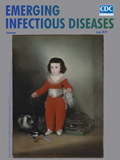
Lassa fever (LF) is endemic to Nigeria, where the disease causes substantial rates of illness and death. In this article, we report an analysis of the epidemiologic and clinical aspects of the LF outbreak that occurred in Nigeria during January 1–May 6, 2018. A total of 1,893 cases were reported; 423 were laboratory-confirmed cases, among which 106 deaths were recorded (case-fatality rate 25.1%). Among all confirmed cases, 37 occurred in healthcare workers. The secondary attack rate among 5,001 contacts was 0.56%. Most (80.6%) confirmed cases were reported from 3 states (Edo, Ondo, and Ebonyi). Fatal outcomes were significantly associated with being elderly; no administration of ribavirin; and the presence of a cough, hemorrhaging, and unconsciousness. The findings in this study should lead to further LF research and provide guidance to those preparing to respond to future outbreaks.
| EID | Ilori EA, Furuse Y, Ipadeola OB, Dan-Nwafor CC, Abubakar A, Womi-Eteng OE, et al. Epidemiologic and Clinical Features of Lassa Fever Outbreak in Nigeria, January 1–May 6, 2018. Emerg Infect Dis. 2019;25(6):1066-1074. https://doi.org/10.3201/eid2506.181035 |
|---|---|
| AMA | Ilori EA, Furuse Y, Ipadeola OB, et al. Epidemiologic and Clinical Features of Lassa Fever Outbreak in Nigeria, January 1–May 6, 2018. Emerging Infectious Diseases. 2019;25(6):1066-1074. doi:10.3201/eid2506.181035. |
| APA | Ilori, E. A., Furuse, Y., Ipadeola, O. B., Dan-Nwafor, C. C., Abubakar, A., Womi-Eteng, O. E....Ihekweazu, C. (2019). Epidemiologic and Clinical Features of Lassa Fever Outbreak in Nigeria, January 1–May 6, 2018. Emerging Infectious Diseases, 25(6), 1066-1074. https://doi.org/10.3201/eid2506.181035. |
Nontuberculous mycobacteria represent an uncommon but important cause of infection of the musculoskeletal system. Such infections require aggressive medical and surgical treatment, and cases are often complicated by delayed diagnosis. We retrospectively reviewed all 14 nonspinal cases of nontuberculous mycobacterial musculoskeletal infections treated over 6 years by orthopedic surgeons at a university-affiliated tertiary referral center. All patients required multiple antimicrobial agents along with aggressive surgical treatment; 13 of 14 patients ultimately achieved cure. Four patients required amputation to control the infection. Half these patients were immunosuppressed by medications or other medical illness when they sought care at the referral center. Six cases involved joint prostheses; all ultimately required hardware removal and placement of an antimicrobial spacer for eradication of infection. Our findings highlight the importance of vigilance for nontuberculous mycobacterial musculoskeletal infection, particularly in patients who are immunosuppressed or have a history of musculoskeletal surgery.
| EID | Goldstein N, St. Clair J, Kasperbauer SH, Daley CL, Lindeque B. Nontuberculous Mycobacterial Musculoskeletal Infection Cases from a Tertiary Referral Center, Colorado, USA. Emerg Infect Dis. 2019;25(6):1075-1083. https://doi.org/10.3201/eid2506.181041 |
|---|---|
| AMA | Goldstein N, St. Clair J, Kasperbauer SH, et al. Nontuberculous Mycobacterial Musculoskeletal Infection Cases from a Tertiary Referral Center, Colorado, USA. Emerging Infectious Diseases. 2019;25(6):1075-1083. doi:10.3201/eid2506.181041. |
| APA | Goldstein, N., St. Clair, J., Kasperbauer, S. H., Daley, C. L., & Lindeque, B. (2019). Nontuberculous Mycobacterial Musculoskeletal Infection Cases from a Tertiary Referral Center, Colorado, USA. Emerging Infectious Diseases, 25(6), 1075-1083. https://doi.org/10.3201/eid2506.181041. |
Volume 25, Number 5—May 2019

Staphylococcus aureus bacteremia (SAB) is a major cause of illness and death worldwide. We analyzed temporal trends of SAB incidence and death in Denmark during 2008–2015. SAB incidence increased 48%, from 20.76 to 30.37 per 100,000 person-years, during this period (p<0.001). The largest change in incidence was observed for persons >80 years of age: a 90% increase in the SAB rate (p<0.001). After adjusting for demographic changes, annual rates increased 4.0% (95% CI 3.0–5.0) for persons <80 years of age, 8.4% (95% CI 7.0–11.0) for persons 80–89 years of age, and 13.0% (95% CI 9.0–17.5) for persons >90 years of age. The 30-day case-fatality rate remained stable at 24%; crude population death rates increased by 53% during 2008–2015 (p<0.001). Specific causes and mechanisms for this rapid increase in SAB incidence among the elderly population remain to be clarified.
| EID | Thorlacius-Ussing L, Sandholdt H, Larsen A, Petersen A, Benfield T. Age-Dependent Increase in Incidence of Staphylococcus aureus Bacteremia, Denmark, 2008–2015. Emerg Infect Dis. 2019;25(5):875-882. https://doi.org/10.3201/eid2505.181733 |
|---|---|
| AMA | Thorlacius-Ussing L, Sandholdt H, Larsen A, et al. Age-Dependent Increase in Incidence of Staphylococcus aureus Bacteremia, Denmark, 2008–2015. Emerging Infectious Diseases. 2019;25(5):875-882. doi:10.3201/eid2505.181733. |
| APA | Thorlacius-Ussing, L., Sandholdt, H., Larsen, A., Petersen, A., & Benfield, T. (2019). Age-Dependent Increase in Incidence of Staphylococcus aureus Bacteremia, Denmark, 2008–2015. Emerging Infectious Diseases, 25(5), 875-882. https://doi.org/10.3201/eid2505.181733. |
Bacillus cereus is associated with foodborne illnesses characterized by vomiting and diarrhea. Although some B. cereus strains that cause severe extraintestinal infections and nosocomial infections are recognized as serious public health threats in healthcare settings, the genetic backgrounds of B. cereus strains causing such infections remain unknown. By conducting pulsed-field gel electrophoresis and multilocus sequence typing, we found that a novel sequence type (ST), newly registered as ST1420, was the dominant ST isolated from the cases of nosocomial infections that occurred in 3 locations in Japan in 2006, 2013, and 2016. Phylogenetic analysis showed that ST1420 strains belonged to the Cereus III lineage, which is much closer to the Anthracis lineage than to other Cereus lineages. Our results suggest that ST1420 is a prevalent ST in B. cereus strains that have caused recent nosocomial infections in Japan.
| EID | Akamatsu R, Suzuki M, Okinaka K, Sasahara T, Yamane K, Suzuki S, et al. Novel Sequence Type in Bacillus cereus Strains Associated with Nosocomial Infections and Bacteremia, Japan. Emerg Infect Dis. 2019;25(5):883-890. https://doi.org/10.3201/eid2505.171890 |
|---|---|
| AMA | Akamatsu R, Suzuki M, Okinaka K, et al. Novel Sequence Type in Bacillus cereus Strains Associated with Nosocomial Infections and Bacteremia, Japan. Emerging Infectious Diseases. 2019;25(5):883-890. doi:10.3201/eid2505.171890. |
| APA | Akamatsu, R., Suzuki, M., Okinaka, K., Sasahara, T., Yamane, K., Suzuki, S....Higashi, H. (2019). Novel Sequence Type in Bacillus cereus Strains Associated with Nosocomial Infections and Bacteremia, Japan. Emerging Infectious Diseases, 25(5), 883-890. https://doi.org/10.3201/eid2505.171890. |
Volume 25, Number 4—April 2019
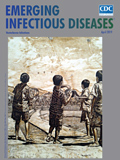
Rickettsioses are endemic to Vietnam; however, only a limited number of clinical studies have been performed on these vectorborne bacteria. We conducted a prospective hospital-based study at 2 national referral hospitals in Hanoi to describe the clinical characteristics of scrub typhus and murine typhus in northern Vietnam and to assess the diagnostic applicability of quantitative real-time PCR assays to diagnose rickettsial diseases. We enrolled 302 patients with acute undifferentiated fever and clinically suspected rickettsiosis during March 2015–March 2017. We used a standardized case report form to collect clinical information and laboratory results at the time of admission and during treatment. We confirmed scrub typhus in 103 (34.1%) patients and murine typhus in 12 (3.3%) patients. These results highlight the need for increased emphasis on training for healthcare providers for earlier recognition, prevention, and treatment of rickettsial diseases in Vietnam.
| EID | Trung N, Hoi L, Dien V, Huong D, Hoa T, Lien V, et al. Clinical Manifestations and Molecular Diagnosis of Scrub Typhus and Murine Typhus, Vietnam, 2015–2017. Emerg Infect Dis. 2019;25(4):633-641. https://doi.org/10.3201/eid2504.180691 |
|---|---|
| AMA | Trung N, Hoi L, Dien V, et al. Clinical Manifestations and Molecular Diagnosis of Scrub Typhus and Murine Typhus, Vietnam, 2015–2017. Emerging Infectious Diseases. 2019;25(4):633-641. doi:10.3201/eid2504.180691. |
| APA | Trung, N., Hoi, L., Dien, V., Huong, D., Hoa, T., Lien, V....Van Kinh, N. (2019). Clinical Manifestations and Molecular Diagnosis of Scrub Typhus and Murine Typhus, Vietnam, 2015–2017. Emerging Infectious Diseases, 25(4), 633-641. https://doi.org/10.3201/eid2504.180691. |
Volume 25, Number 3—March 2019

Extensively drug-resistant tuberculosis (XDR TB) has extremely poor treatment outcomes in adults. Limited data are available for children. We report on clinical manifestations, treatment, and outcomes for 37 children (<15 years of age) with bacteriologically confirmed XDR TB in 11 countries. These patients were managed during 1999–2013. For the 37 children, median age was 11 years, 32 (87%) had pulmonary TB, and 29 had a recorded HIV status; 7 (24%) were infected with HIV. Median treatment duration was 7.0 months for the intensive phase and 12.2 months for the continuation phase. Thirty (81%) children had favorable treatment outcomes. Four (11%) died, 1 (3%) failed treatment, and 2 (5%) did not complete treatment. We found a high proportion of favorable treatment outcomes among children, with mortality rates markedly lower than for adults. Regimens and duration of treatment varied considerably. Evaluation of new regimens in children is required.
| EID | Osman M, Harausz EP, Garcia-Prats AJ, Schaaf H, Moore BK, Hicks RM, et al. Treatment Outcomes in Global Systematic Review and Patient Meta-Analysis of Children with Extensively Drug-Resistant Tuberculosis. Emerg Infect Dis. 2019;25(3):441-450. https://doi.org/10.3201/eid2503.180852 |
|---|---|
| AMA | Osman M, Harausz EP, Garcia-Prats AJ, et al. Treatment Outcomes in Global Systematic Review and Patient Meta-Analysis of Children with Extensively Drug-Resistant Tuberculosis. Emerging Infectious Diseases. 2019;25(3):441-450. doi:10.3201/eid2503.180852. |
| APA | Osman, M., Harausz, E. P., Garcia-Prats, A. J., Schaaf, H., Moore, B. K., Hicks, R. M....Hesseling, A. C. (2019). Treatment Outcomes in Global Systematic Review and Patient Meta-Analysis of Children with Extensively Drug-Resistant Tuberculosis. Emerging Infectious Diseases, 25(3), 441-450. https://doi.org/10.3201/eid2503.180852. |
Mycobacterium bovis bacillus Calmette-Guérin (BCG) is used as a vaccine to protect against disseminated tuberculosis (TB) and as a treatment for bladder cancer. We describe characteristics of US TB patients reported to the National Tuberculosis Surveillance System (NTSS) whose disease was attributed to BCG. We identified 118 BCG cases and 91,065 TB cases reported to NTSS during 2004–2015. Most patients with BCG were US-born (86%), older (median age 75 years), and non-Hispanic white (81%). Only 17% of BCG cases had pulmonary involvement, in contrast with 84% of TB cases. Epidemiologic features of BCG cases differed from TB cases. Clinicians can use clinical history to discern probable BCG cases from TB cases, enabling optimal clinical management. Public health agencies can use this information to quickly identify probable BCG cases to avoid inappropriately reporting BCG cases to NTSS or expending resources on unnecessary public health interventions.
| EID | Wansaula Z, Wortham JM, Mindra G, Haddad MB, Salinas JL, Ashkin D, et al. Bacillus Calmette-Guérin Cases Reported to the National Tuberculosis Surveillance System, United States, 2004–2015. Emerg Infect Dis. 2019;25(3):451-456. https://doi.org/10.3201/eid2503.180686 |
|---|---|
| AMA | Wansaula Z, Wortham JM, Mindra G, et al. Bacillus Calmette-Guérin Cases Reported to the National Tuberculosis Surveillance System, United States, 2004–2015. Emerging Infectious Diseases. 2019;25(3):451-456. doi:10.3201/eid2503.180686. |
| APA | Wansaula, Z., Wortham, J. M., Mindra, G., Haddad, M. B., Salinas, J. L., Ashkin, D....Langer, A. J. (2019). Bacillus Calmette-Guérin Cases Reported to the National Tuberculosis Surveillance System, United States, 2004–2015. Emerging Infectious Diseases, 25(3), 451-456. https://doi.org/10.3201/eid2503.180686. |
Volume 25, Number 2—February 2019

Infection with West Nile virus (WNV) has a well-characterized acute disease process. However, long-term consequences are less understood. We searched death records for 4,142 residents of Texas, USA, infected with WNV during 2002–2012 and identified 557 (13%) deaths. We analyzed all-cause and cause-specific deaths after WNV infection by calculating standardized mortality ratios and using statewide mortality data. Acute-phase deaths (<90 days after symptom onset) occurred in 289 (7%) of case-patients; of those deaths, 289 (92%) were cases of West Nile neuroinvasive disease (WNND). Convalescent-phase deaths (>90 days after symptom onset) occurred in 268 (7%) of the remaining 3,853 case-patients; 210 (78%) of these deaths occurred in patients with WNND. Convalescent-phase WNND case-patients showed excess deaths from infectious and renal causes; case-patients <60 years of age had increased risk for all-cause death, specifically from renal, infectious, digestive, and circulatory causes. We provide population-level evidence of increased risk for death after WNV infection resulting in WNND.
| EID | Philpott D, Nolan MS, Evert N, Mayes B, Hesalroad D, Fonken E, et al. Acute and Delayed Deaths after West Nile Virus Infection, Texas, USA, 2002–2012. Emerg Infect Dis. 2019;25(2):256-264. https://doi.org/10.3201/eid2502.181250 |
|---|---|
| AMA | Philpott D, Nolan MS, Evert N, et al. Acute and Delayed Deaths after West Nile Virus Infection, Texas, USA, 2002–2012. Emerging Infectious Diseases. 2019;25(2):256-264. doi:10.3201/eid2502.181250. |
| APA | Philpott, D., Nolan, M. S., Evert, N., Mayes, B., Hesalroad, D., Fonken, E....Murray, K. O. (2019). Acute and Delayed Deaths after West Nile Virus Infection, Texas, USA, 2002–2012. Emerging Infectious Diseases, 25(2), 256-264. https://doi.org/10.3201/eid2502.181250. |
| EID | Körmöndi S, Terhes G, Pál Z, Varga E, Harmati M, Buzás K, et al. Human Pasteurellosis Health Risk for Elderly Persons Living with Companion Animals. Emerg Infect Dis. 2019;25(2):229-235. https://doi.org/10.3201/eid2502.180641 |
|---|---|
| AMA | Körmöndi S, Terhes G, Pál Z, et al. Human Pasteurellosis Health Risk for Elderly Persons Living with Companion Animals. Emerging Infectious Diseases. 2019;25(2):229-235. doi:10.3201/eid2502.180641. |
| APA | Körmöndi, S., Terhes, G., Pál, Z., Varga, E., Harmati, M., Buzás, K....Urbán, E. (2019). Human Pasteurellosis Health Risk for Elderly Persons Living with Companion Animals. Emerging Infectious Diseases, 25(2), 229-235. https://doi.org/10.3201/eid2502.180641. |
Zika virus infection during pregnancy may result in birth defects and pregnancy complications. We describe the Zika virus outbreak in pregnant women in the Dominican Republic during 2016–2017. We conducted multinomial logistic regression to identify factors associated with fetal losses and preterm birth. The Ministry of Health identified 1,282 pregnant women with suspected Zika virus infection, a substantial proportion during their first trimester. Fetal loss was reported for ≈10% of the reported pregnancies, and 3 cases of fetal microcephaly were reported. Women infected during the first trimester were more likely to have early fetal loss (adjusted odds ratio 5.9, 95% CI 3.5–10.0). Experiencing fever during infection was associated with increased odds of premature birth (adjusted odds ratio 1.65, 95% CI 1.03–2.65). There was widespread morbidity during the epidemic. Our findings strengthen the evidence for a broad range of adverse pregnancy outcomes resulting from Zika virus infection.
| EID | Peña F, Pimentel R, Khosla S, Mehta SD, Brito MO. Zika Virus Epidemic in Pregnant Women, Dominican Republic, 2016–2017. Emerg Infect Dis. 2019;25(2):247-255. https://doi.org/10.3201/eid2502.181054 |
|---|---|
| AMA | Peña F, Pimentel R, Khosla S, et al. Zika Virus Epidemic in Pregnant Women, Dominican Republic, 2016–2017. Emerging Infectious Diseases. 2019;25(2):247-255. doi:10.3201/eid2502.181054. |
| APA | Peña, F., Pimentel, R., Khosla, S., Mehta, S. D., & Brito, M. O. (2019). Zika Virus Epidemic in Pregnant Women, Dominican Republic, 2016–2017. Emerging Infectious Diseases, 25(2), 247-255. https://doi.org/10.3201/eid2502.181054. |
Volume 25, Number 1—January 2019
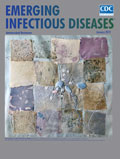
We conducted an observational study from January 2016 through January 2017 of patients admitted to a reference pediatric hospital in Madrid, Spain, for neurologic symptoms and enterovirus infection. Among the 30 patients, the most common signs and symptoms were fever, lethargy, myoclonic jerks, and ataxia. Real-time PCR detected enterovirus in the cerebrospinal fluid of 8 patients, nasopharyngeal aspirate in 17, and anal swab samples of 5. The enterovirus was genotyped for 25 of 30 patients; enterovirus A71 was the most common serotype (21/25) and the only serotype detected in patients with brainstem encephalitis or encephalomyelitis. Treatment was intravenous immunoglobulins for 21 patients and corticosteroids for 17. Admission to the pediatric intensive care unit was required for 14 patients. All patients survived. At admission, among patients with the most severe disease, leukocytes were elevated. For children with brainstem encephalitis or encephalomyelitis, clinicians should look for enterovirus and not limit testing to cerebrospinal fluid.
| EID | Taravilla C, Pérez-Sebastián I, Salido A, Serrano C, Extremera V, Rodríguez A, et al. Enterovirus A71 Infection and Neurologic Disease, Madrid, Spain, 2016. Emerg Infect Dis. 2019;25(1):25-32. https://doi.org/10.3201/eid2501.181089 |
|---|---|
| AMA | Taravilla C, Pérez-Sebastián I, Salido A, et al. Enterovirus A71 Infection and Neurologic Disease, Madrid, Spain, 2016. Emerging Infectious Diseases. 2019;25(1):25-32. doi:10.3201/eid2501.181089. |
| APA | Taravilla, C., Pérez-Sebastián, I., Salido, A., Serrano, C., Extremera, V., Rodríguez, A....González, A. (2019). Enterovirus A71 Infection and Neurologic Disease, Madrid, Spain, 2016. Emerging Infectious Diseases, 25(1), 25-32. https://doi.org/10.3201/eid2501.181089. |
Antimicrobial drug resistance is a serious health hazard driven by overuse. Administration of antimicrobial drugs to HIV-exposed, uninfected infants, a population that is growing and at high risk for infection, is poorly studied. We therefore analyzed factors associated with antibacterial drug administration to HIV-exposed, uninfected infants during their first year of life. Our study population was 2,152 HIV-exposed, uninfected infants enrolled in the Breastfeeding, Antiretrovirals and Nutrition study in Lilongwe, Malawi, during 2004–2010. All infants were breastfed through 28 weeks of age. Antibacterial drugs were prescribed frequently (to 80% of infants), and most (67%) of the 5,329 prescriptions were for respiratory indications. Most commonly prescribed were penicillins (43%) and sulfonamides (23%). Factors associated with lower hazard for antibacterial drug prescription included receipt of cotrimoxazole preventive therapy, receipt of antiretroviral drugs, and increased age. Thus, cotrimoxazole preventive therapy may lead to fewer prescriptions for antibacterial drugs for these infants.
| EID | Ewing AC, Davis NL, Kayira D, Hosseinipour MC, van der Horst C, Jamieson DJ, et al. Prescription of Antibacterial Drugs for HIV-Exposed, Uninfected Infants, Malawi, 2004–2010. Emerg Infect Dis. 2019;25(1):103-112. https://doi.org/10.3201/eid2501.180782 |
|---|---|
| AMA | Ewing AC, Davis NL, Kayira D, et al. Prescription of Antibacterial Drugs for HIV-Exposed, Uninfected Infants, Malawi, 2004–2010. Emerging Infectious Diseases. 2019;25(1):103-112. doi:10.3201/eid2501.180782. |
| APA | Ewing, A. C., Davis, N. L., Kayira, D., Hosseinipour, M. C., van der Horst, C., Jamieson, D. J....Kourtis, A. P. (2019). Prescription of Antibacterial Drugs for HIV-Exposed, Uninfected Infants, Malawi, 2004–2010. Emerging Infectious Diseases, 25(1), 103-112. https://doi.org/10.3201/eid2501.180782. |
CME Articles by Volume




